Toward Smart Soil Sensing in v4.0 Agriculture: A New Single-Shape Sensor for Capacitive Moisture and Salinity Measurements
Abstract
1. Introduction
2. Materials and Methodology
2.1. Calibrating Samples
2.2. Basic Design Approach
- Easy insertion into the soil. An auger with a standard diameter is used to make a pilot hole.
- Soil is minimally de-structured around the sensor to avoid external influences on the measurements.
2.2.1. Dimensioning
- If we reduce inter-electrode space, capacity is smaller, and sensitivity is reduced by 11%, from an initial 0.265 pF/% to 0.235 pF/%. This dimensional variation is therefore not viable. The augmentation of this space increases the size of the sensor and thus also its cost. It is preferable, therefore, to preserve a 10mm space between electrodes.
- If we increase the electrode width, we increase the capacity as well as the sensitivity of the sensitive element. In fact, we go from 0.265 pF/% to 0.367 pF/%, an increase of 38%. However, we also increase the electrode surface by 67%, which raises its cost. The increase in sensitivity is not significant enough to justify the resulting cost increase.
- If we reduce the electrodes’ width, we reduce sensitivity, but we lower the cost.
2.2.2. Electrodes Materials Choice
2.3. Toward New Shapes with Higher Performance
2.3.1. New Sensor’s Shape
2.3.2. Performance of These New Shapes
2.3.3. Choice of the Final Shape
2.4. Modeling the Helicoidal-Shaped Sensor
2.4.1. Frequency Analysis
- Capacity variations are inversely proportionate to moisture in the soil, which confirms the theoretical functioning.
- As expected, the capacity is not fixed depending on the frequency, but the more the frequency increases, the more the capacity diminishes until it reaches approximately 15 MHz.
- Beyond this frequency, the inductive parasitic effect is no longer negligible. This demonstrates that beyond 15 MHz, it becomes difficult to devise an exploitable electronic conditioner as measurements are carried out below this frequency.
2.4.2. Coating Effect
- First, field lines close to the sensor only traverse the plastic and not the soil. This creates parasitic capacity wherever the dielectric is in the plastic coating. Since this plastic is hermetic, its parameters are independent of moisture.
- Second, far-off field lines traverse the soil and traverse a layer of plastic coating, which produces a series of parasitic capacity in addition to soil measurement capacity.
- The curve of the molded transducer is higher at every point. It reflects the increase in C’hum0, estimated at 14.7 pF.
- Sensitivity is reduced by 12%, with an estimated value of 0.3875 pF/%. This is measurable by our system with a relative variation of 1% in moisture.
2.4.3. Equivalent Sensors’ Electrical Models
2.5. Electronics Measurements
2.5.1. Architecture
2.5.2. Material Integration
- On the left of the graphic, we can see the plastic tubing. It serves as a reference to measure the height of the electrodes.
- On the right, the measurement of the metallic deposit’s average height: 24 µm (20 µm Cu, 4 µm NiAu) is illustrated.
2.5.3. From the Sensor to the Final User
- A concentrator supervises each sensor. Each concentrator can collect data from four sensors. It then communicates this data by a wire connection with a specific SDI-12 protocol, either by a radiofrequency link on the ISM 868 MHz band to allow total control of the exchange protocol. Tests demonstrate a radio range of 600 m with a baud rate of 9600 bits/s. The concentrator’s energy autonomy is provided by four AA batteries that last for an entire irrigation season (about 8 months). Figure 30 shows the electronic board.
- Data then goes through the other network nodes that could be concentrators used in repeating mode or weather data collection points that also could serve as the bridge.
- Data finally arrives at a base station connected to the Internet, where information is stored on an online server. From then on, the user can consult the data through a web interface or mobile application.
2.6. Experimental Results on Site
2.7. Longitudinal Moisture Measurements
3. Conclusions
Author Contributions
Funding
Acknowledgments
Conflicts of Interest
References
- Faybishenko, B.A. Tensiometer for shallow and deep measurements of water pressure in vadose zone and groundwater. Soil Sci. 2000, 165, 473–482. [Google Scholar] [CrossRef]
- Hayashi, M.; Van Der Kamp, G.; Rudolph, D.L. Use of tensiometer response time to determine the hydraulic conductivity of unsaturated soil. Soil Sci. 1997, 162, 566–575. [Google Scholar] [CrossRef]
- Trotter, C.M. Errors in reading tensiometer vacua with pressure transducers. Soil Sci. 1984, 138, 314–316. [Google Scholar] [CrossRef]
- Gao, Z.; Zhu, Y.; Liu, C.; Qian, H.; Cao, W.; Ni, J. Design and Test of a Soil Profile Moisture Sensor Based on Sensitive Soil Layers. Sensors 2018, 18, 1648. [Google Scholar] [CrossRef] [PubMed]
- Dean, T.; Bell, J.; Baty, A. Soil moisture measurement by an improved capacitance technique, Part I. Sensor design and performance. J. Hydrol. 1987, 93, 67–78. [Google Scholar] [CrossRef]
- Buckman, H.O.; Brady, N.C. The Nature and Properties of Soils. Soil Sci. 1960, 90, 212. [Google Scholar] [CrossRef]
- Chakraborty, M.; Kalita, A.; Biswas, K. PMMA-Coated Capacitive Type Soil Moisture Sensor: Design, Fabrication, and Testing. IEEE Trans. Instrum. Meas. 2018, 68, 189–196. [Google Scholar] [CrossRef]
- Kalita, H.; Palaparthy, V.S.; Baghini, M.S.; Aslam, M. Graphene quantum dot soil moisture sensor. Sens. Actuators B Chem. 2016, 233, 582–590. [Google Scholar] [CrossRef]
- Palaparthy, V.S.; Kalita, H.; Surya, S.G.; Baghini, M.S.; Aslam, M. Graphene oxide based soil moisture microsensor for in situ agriculture applications. Sens. Actuators B Chem. 2018, 273, 1660–1669. [Google Scholar] [CrossRef]
- Boudaden, J.; Steinmaßl, M.; Endres, H.-E.; Drost, A.; Eisele, I.; Kutter, C.; Müller-Buschbaum, P. Polyimide-Based Capacitive Humidity Sensor. Sensors 2018, 18, 1516. [Google Scholar] [CrossRef]
- Xiao, D.; Feng, J.; Wang, N.; Luo, X.; Hu, Y. Integrated soil moisture and water depth sensor for paddy fields. Comput. Electron. Agric. 2013, 98, 214–221. [Google Scholar] [CrossRef]
- Dias, P.C.; Cadavid, D.; Ortega, S.; Ruiz, A.; França, M.B.M.; França, M.B.D.M.; Ferreira, E.C.; Cabot, A. Autonomous soil moisture sensor based on nanostructured thermosensitive resistors powered by an integrated thermoelectric generator. Sens. Actuators A Phys. 2016, 239, 1–7. [Google Scholar] [CrossRef]
- Ding, J.; Chandra, R. Towards Low Cost Soil Sensing Using Wi-Fi. In Proceedings of the 25th Annual International Conference on Mobile Computing and Networking, Los Cabos, Mexico, 21–25 October 2019; p. 39. [Google Scholar]
- Pichorim, S.F.; Gomes, N.J.; Batchelor, J.C. Two Solutions of Soil Moisture Sensing with RFID for Landslide Monitoring. Sensors 2018, 18, 452. [Google Scholar] [CrossRef] [PubMed]
- Rezaei, M.; Ebrahimi, E.; Naseh, S.; Mohajerpour, M. A new 1.4-GHz soil moisture sensor. Measurement 2012, 45, 1723–1728. [Google Scholar] [CrossRef]
- Aljoumani, B.; Sánchez-Espigares, J.A.; Wessolek, G.; Josa, R.; Cañameras, N. Transfer Function and Time Series Outlier Analysis: Modelling Soil Salinity in Loamy Sand Soil by Including the Influences of Irrigation Management and Soil Temperature. Irrig. Drain. 2017, 67, 282–294. [Google Scholar] [CrossRef]
- Singh, J.; Lo, T.; Rudnick, D.; Dorr, T.; Burr, C.; Werle, R.; Shaver, T.; Muñoz-Arriola, F. Performance assessment of factory and field calibrations for electromagnetic sensors in a loam soil. Agric. Water Manag. 2018, 196, 87–98. [Google Scholar] [CrossRef]
- Dalton, F.N.; Herkelrath, W.N.; Rawlins, D.S.; Rhoades, J.D. Time-Domain Reflectometry: Simultaneous Measurement of Soil Water Content and Electrical Conductivity with a Single Probe. Science 1984, 224, 989–990. [Google Scholar] [CrossRef]
- Corwin, D.; Yemoto, K. Measurement of Soil Salinity: Electrical Conductivity and Total Dissolved Solids. Soil Sci. Soc. Am. J. 2019, 83, 1–2. [Google Scholar] [CrossRef]
- Visacro, S.; Alipio, R.; Vale, M.H.M.; Pereira, C. The Response of Grounding Electrodes to Lightning Currents: The Effect of Frequency-Dependent Soil Resistivity and Permittivity. IEEE Trans. Electromagn. Compat. 2011, 53, 401–406. [Google Scholar] [CrossRef]
- Boada, M.; Lazaro, A.; Villarino, R.; Girbau, D. Battery-Less Soil Moisture Measurement System Based on a NFC Device With Energy Harvesting Capability. IEEE Sens. J. 2018, 18, 5541–5549. [Google Scholar] [CrossRef]
- Da Costa, E.F.; De Oliveira, N.E.; França, M.B.D.M.; Carvalhaes-Dias, P.; Duarte, L.F.; Cabot, A.; Dias, J.A.S. A Self-Powered and Autonomous Fringing Field Capacitive Sensor Integrated into a Micro Sprinkler Spinner to Measure Soil Water Content. Sensors 2017, 17, 575. [Google Scholar] [CrossRef] [PubMed]
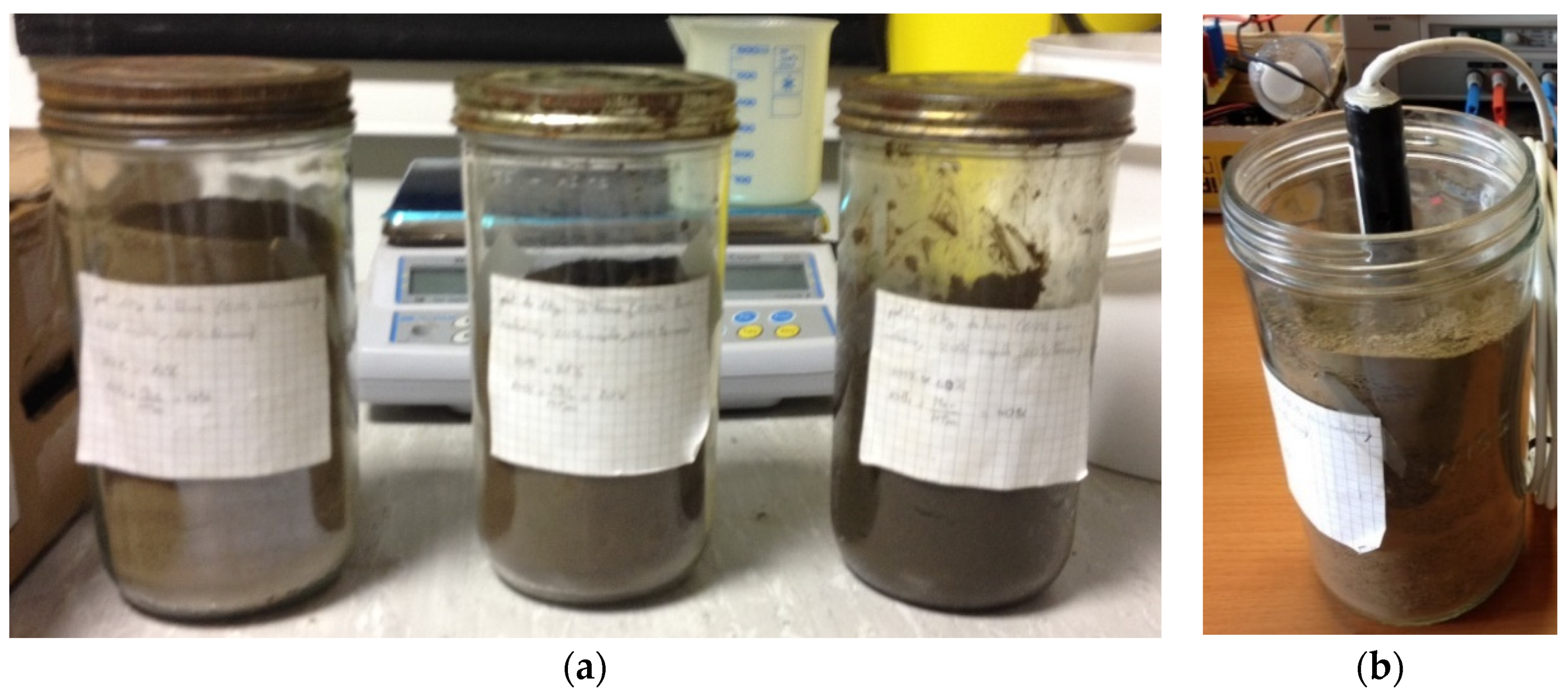



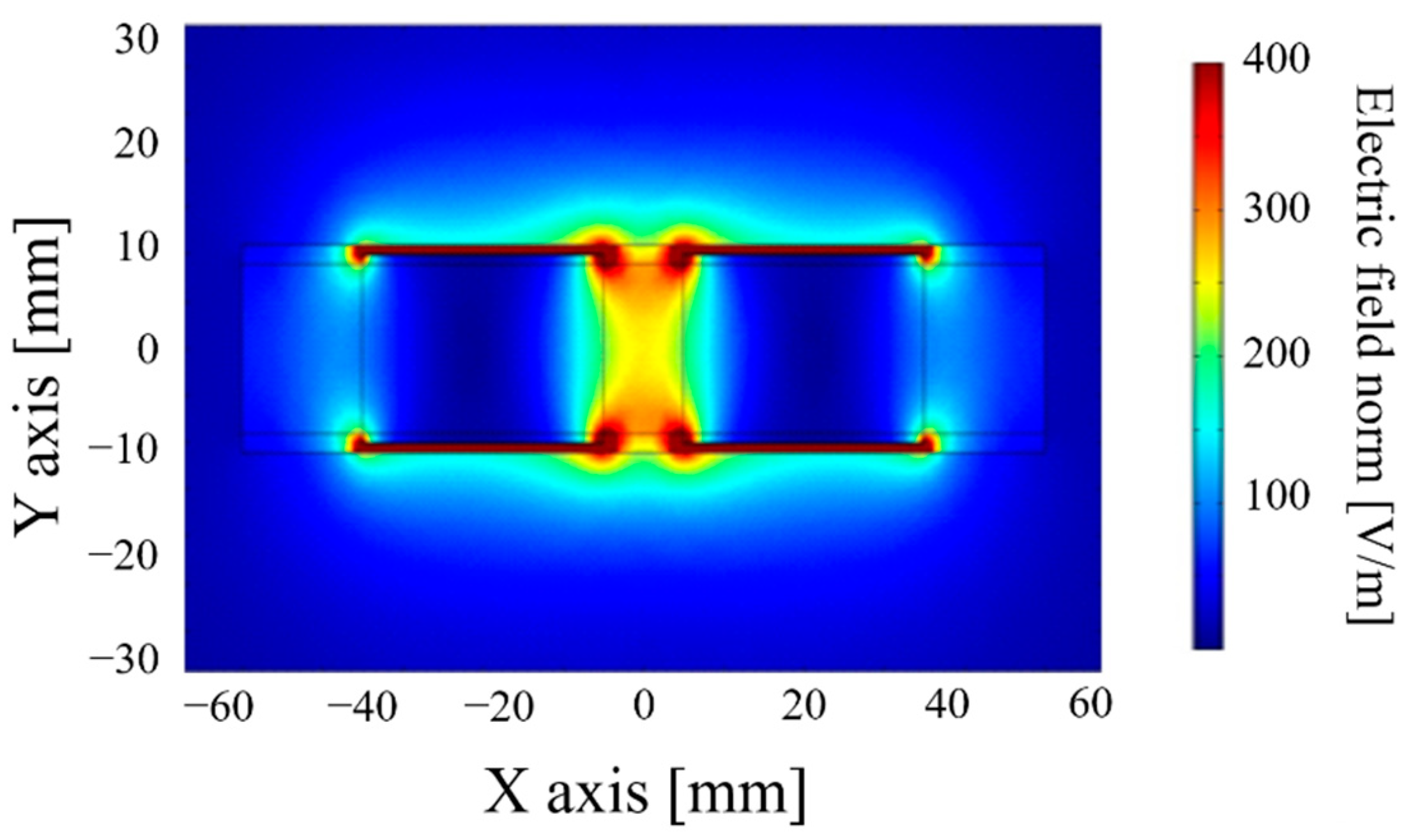

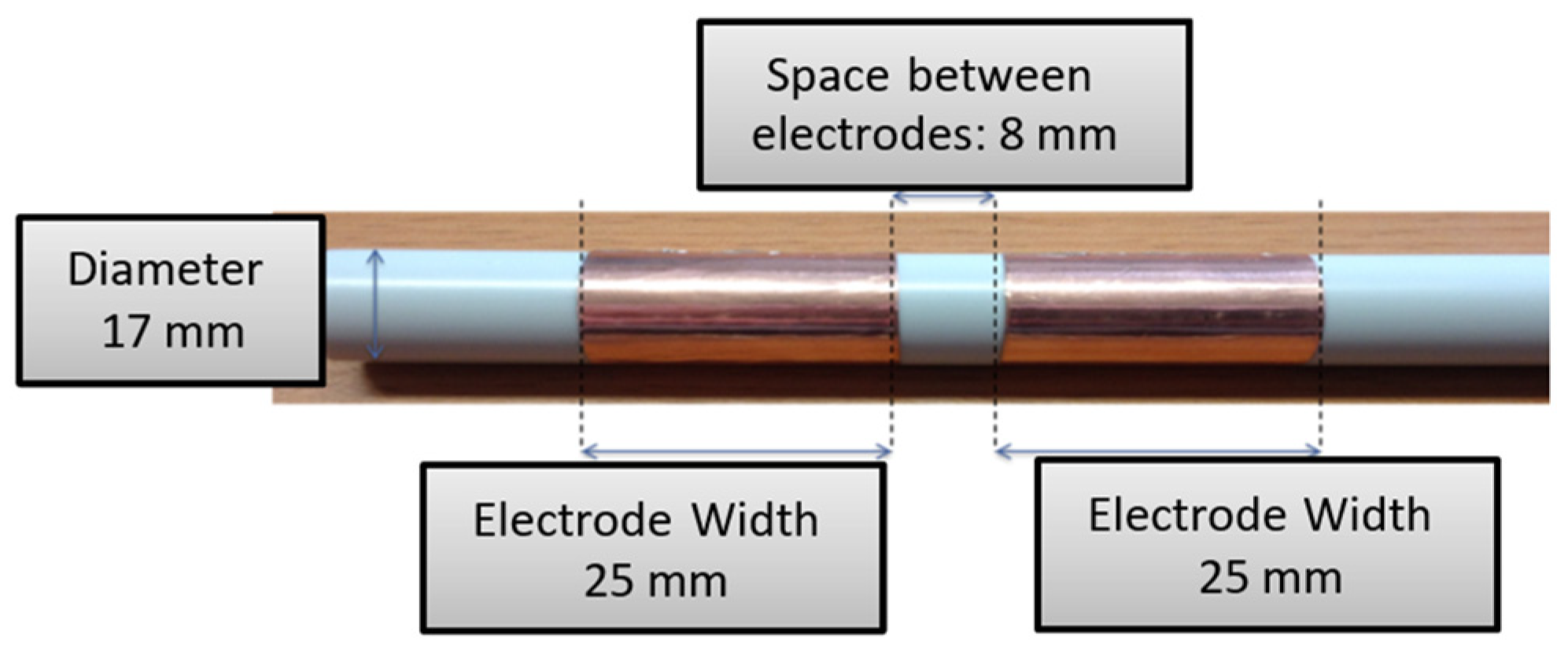
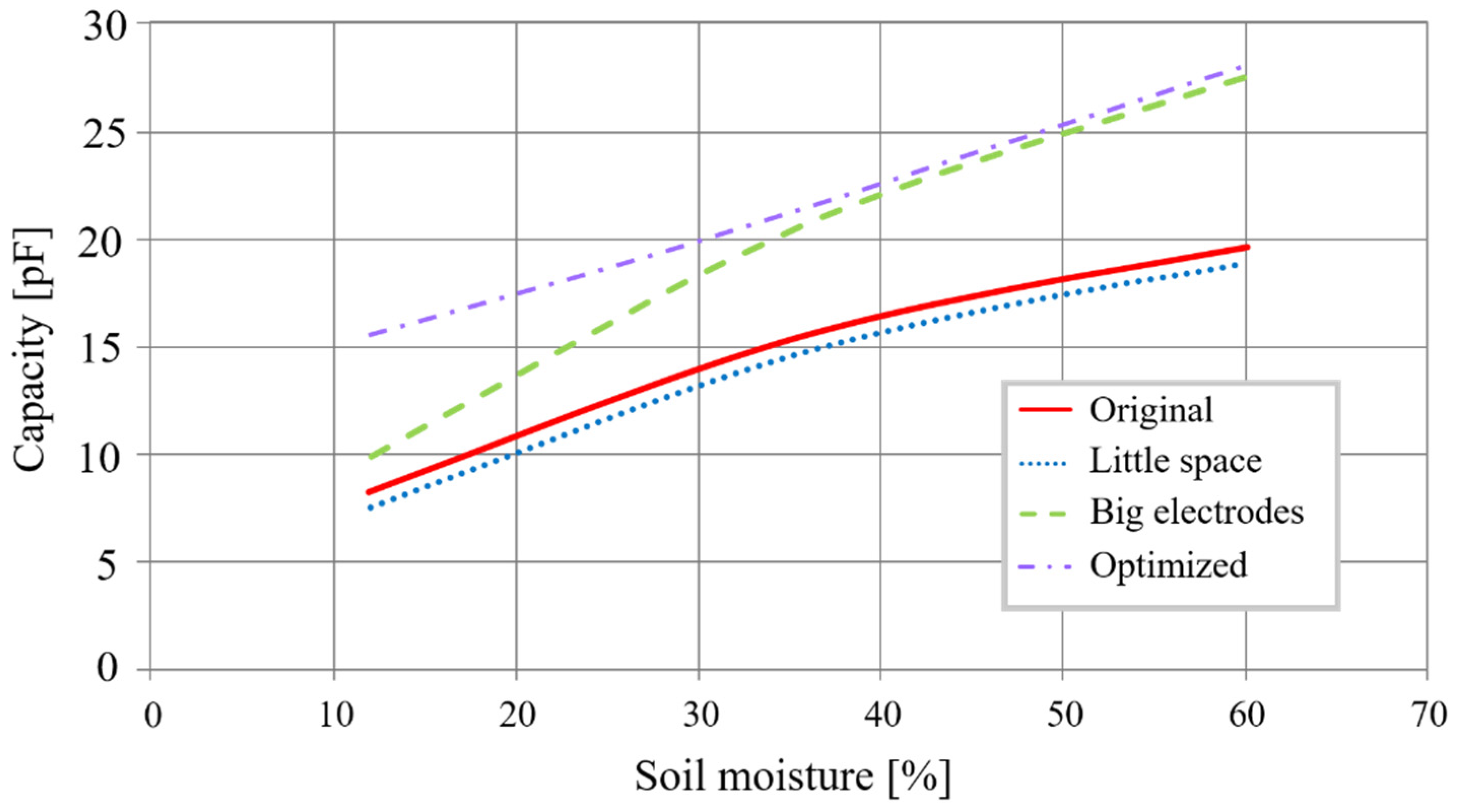

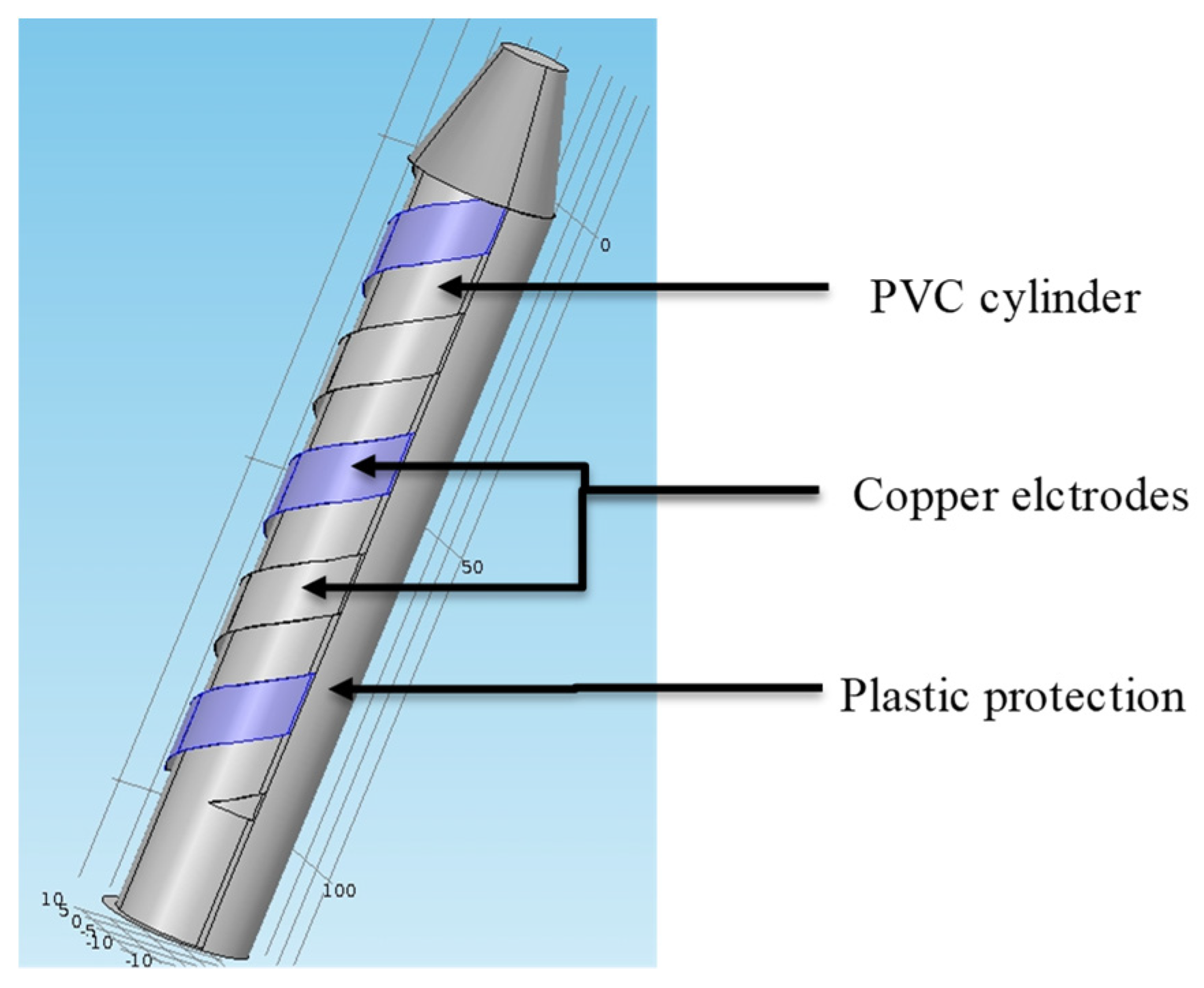


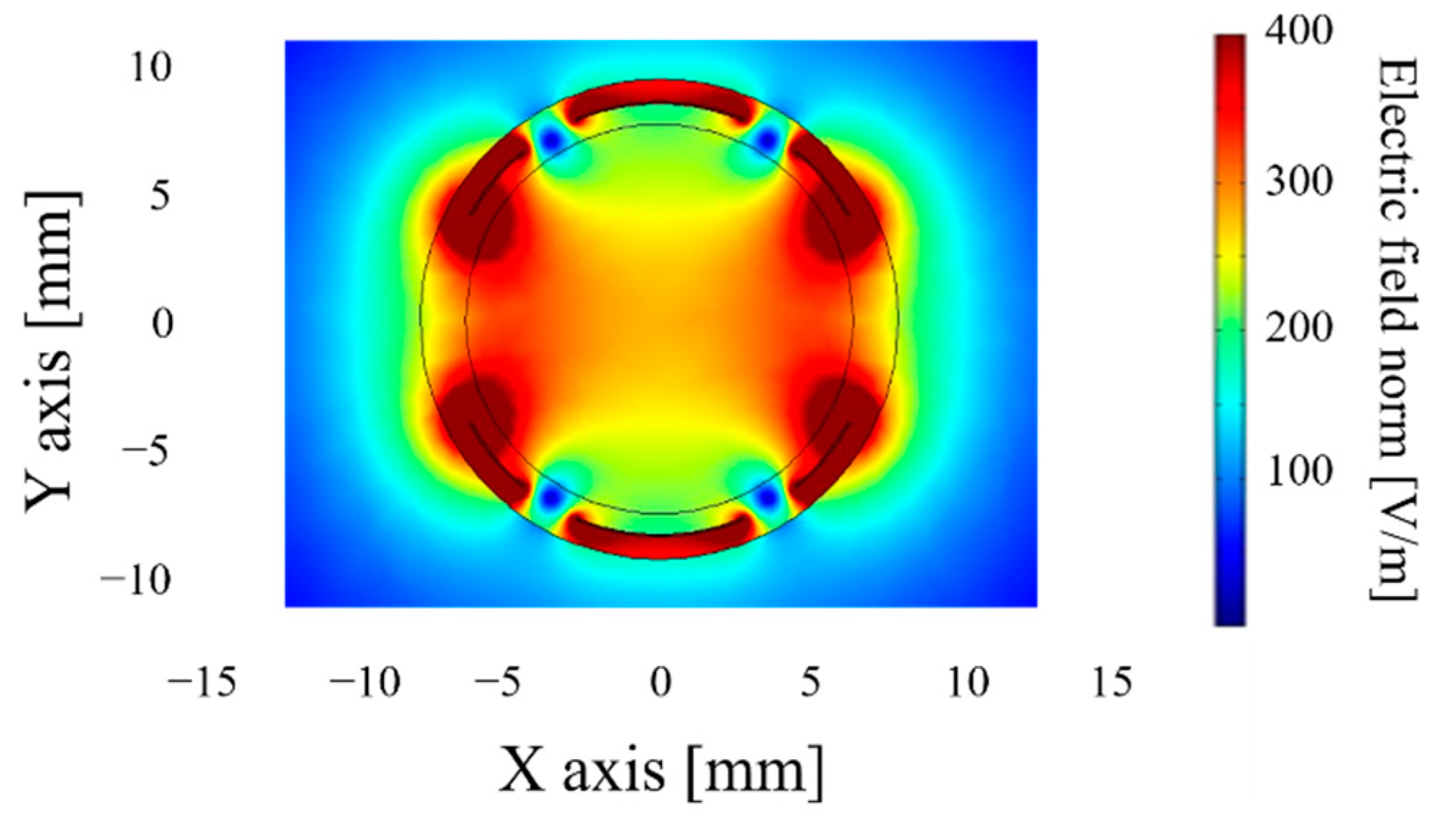

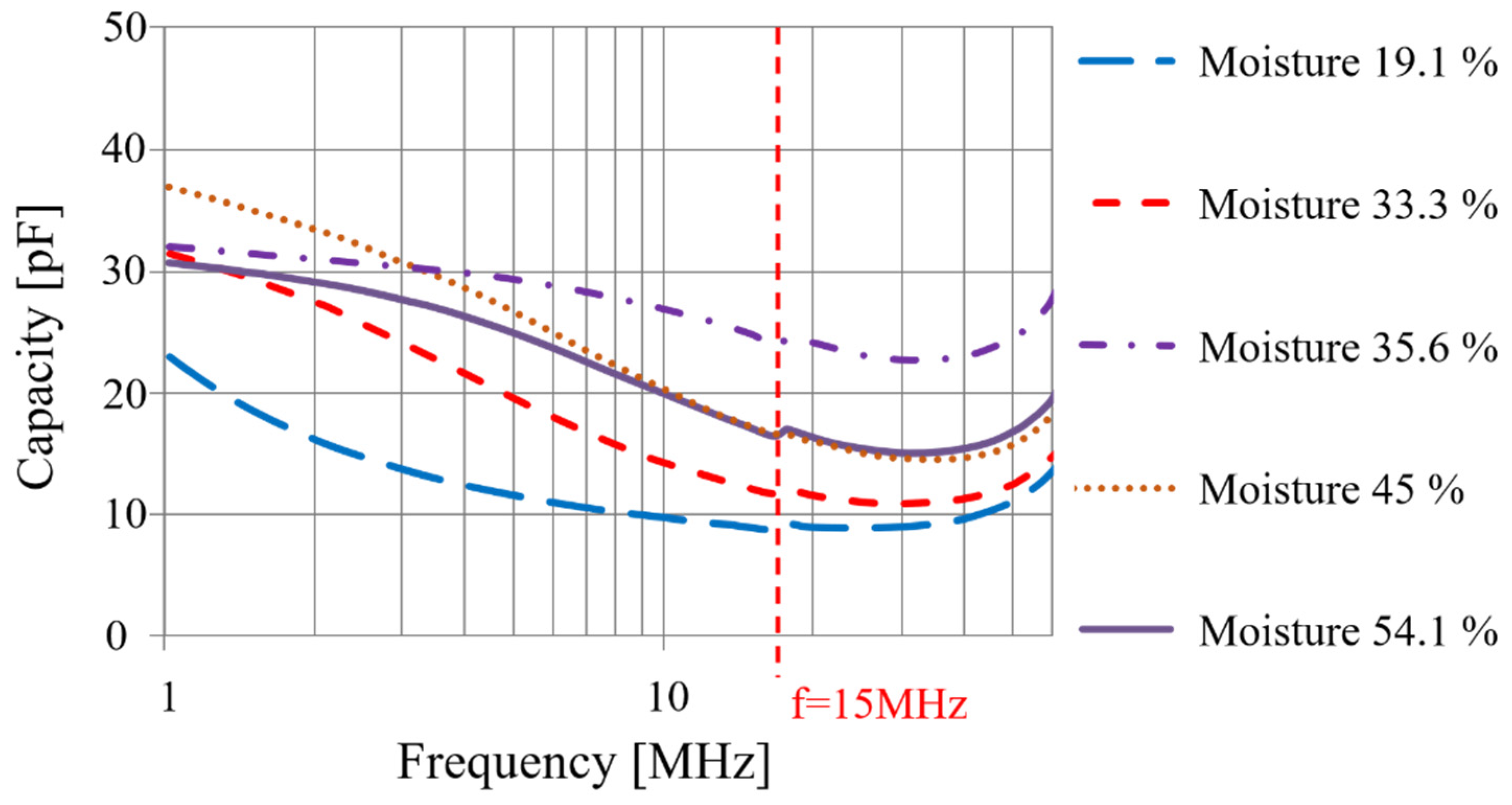





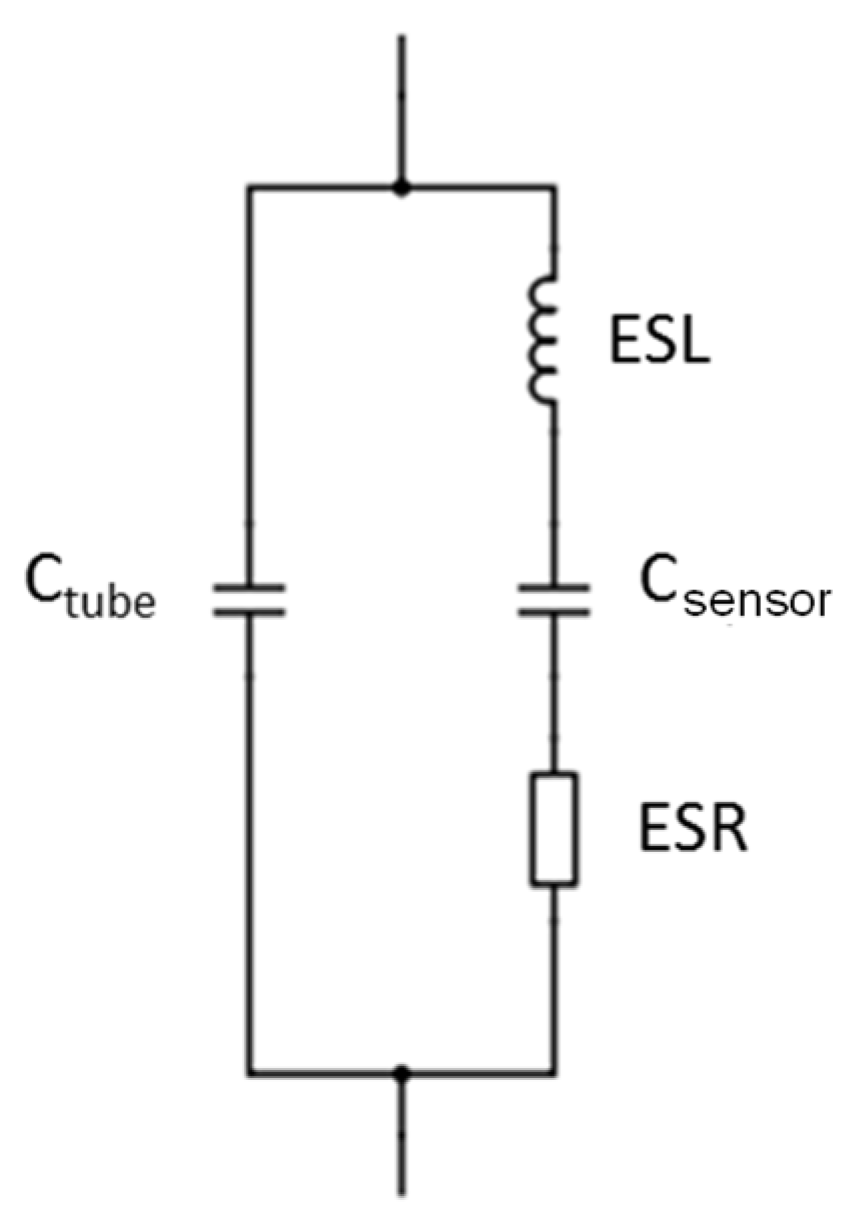

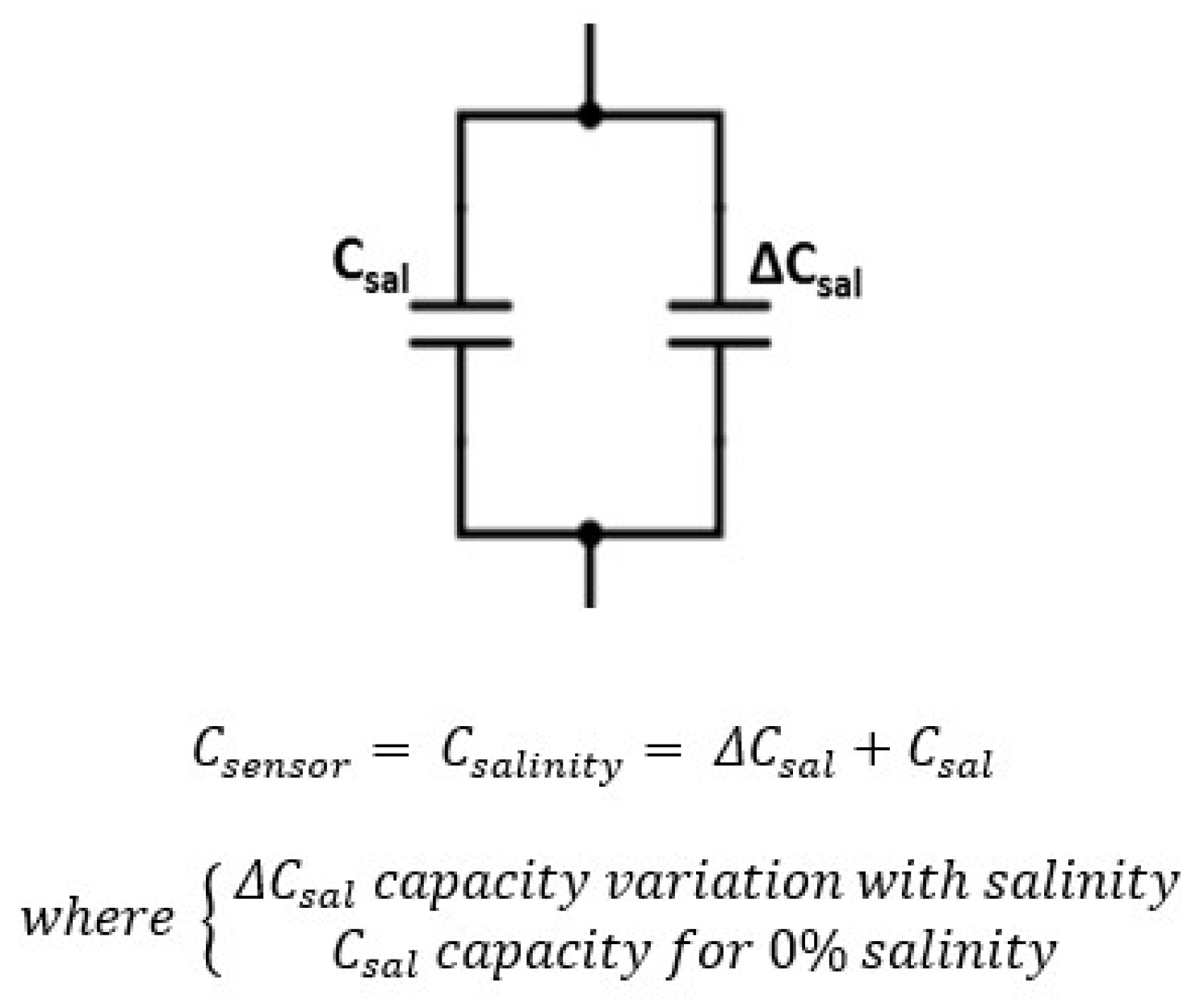



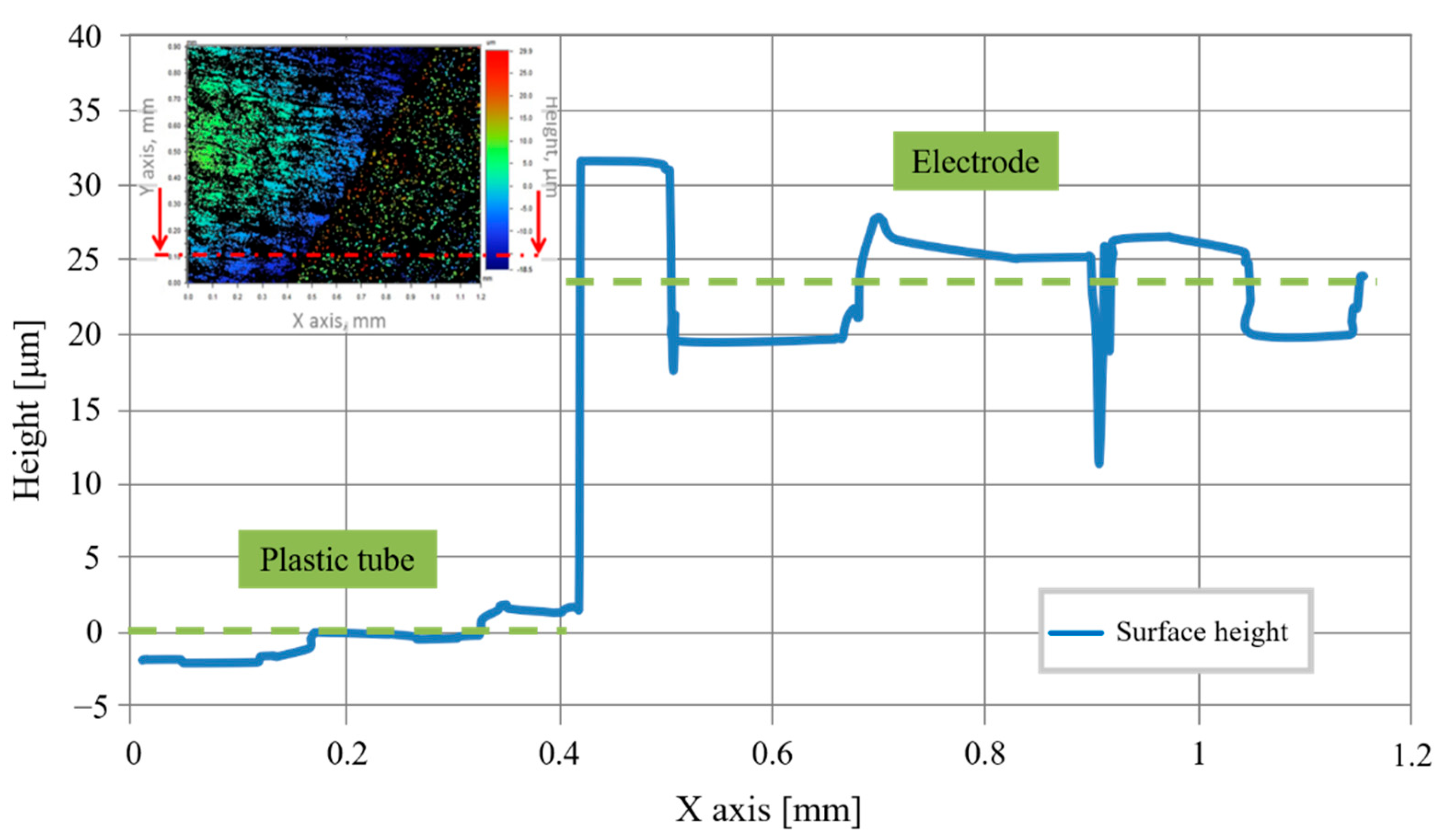
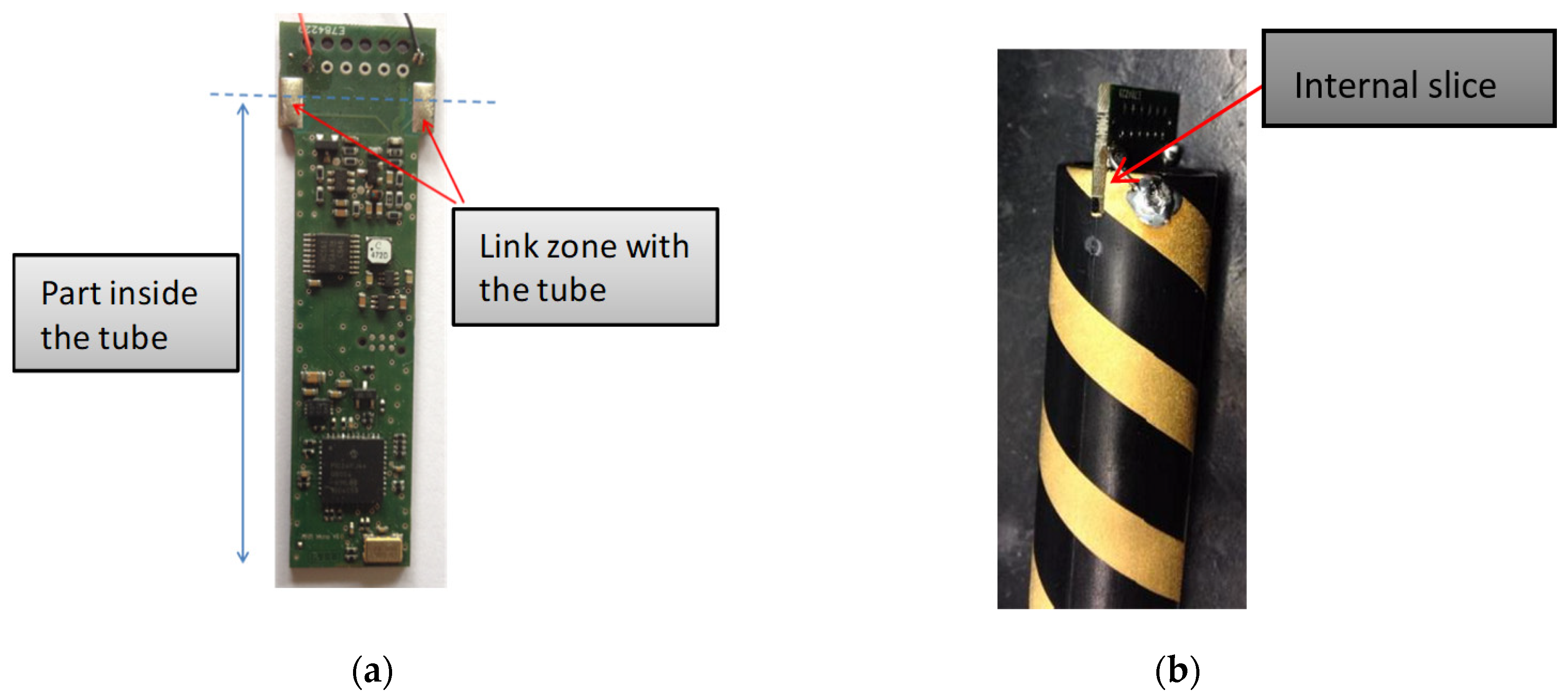
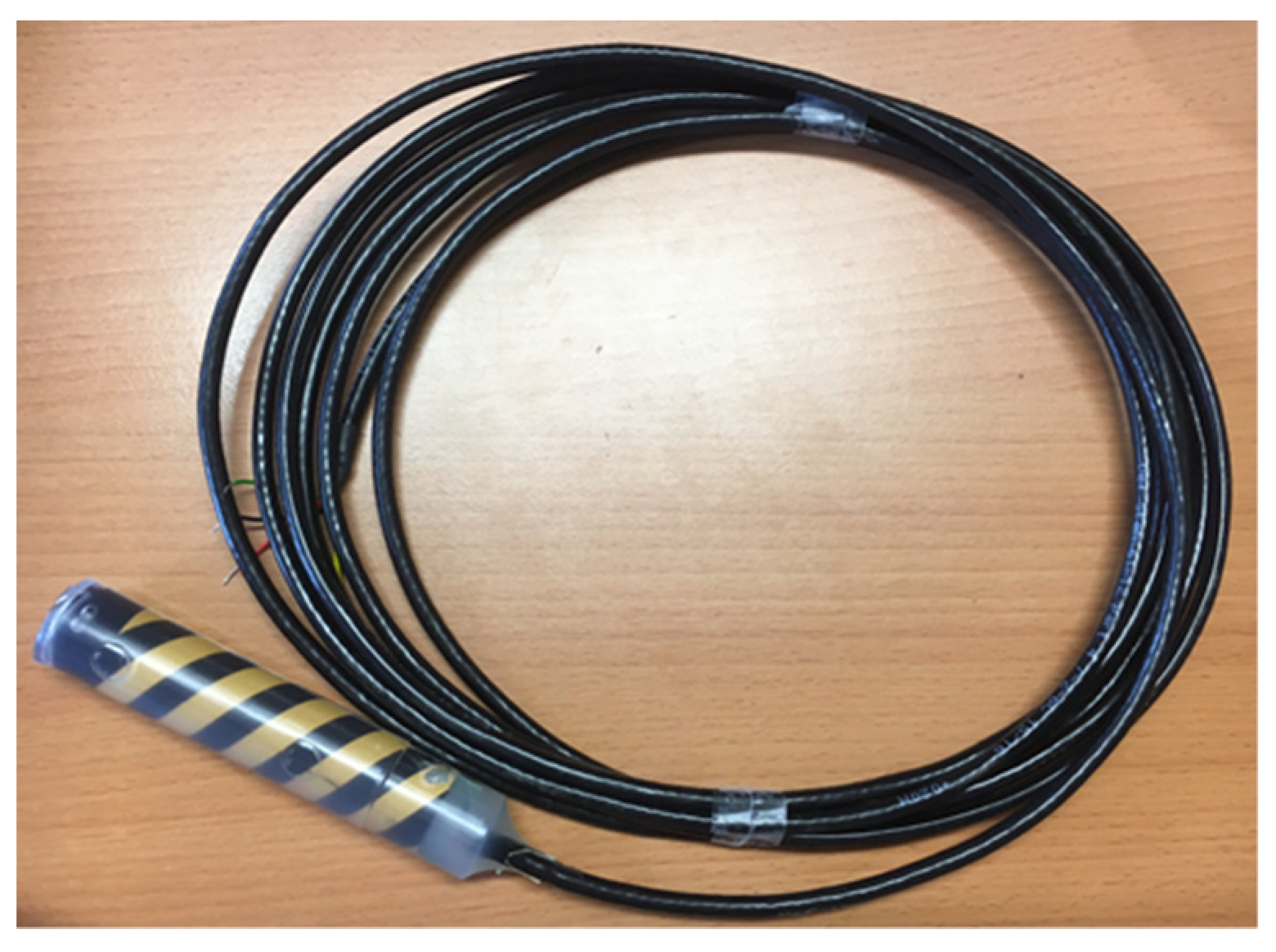
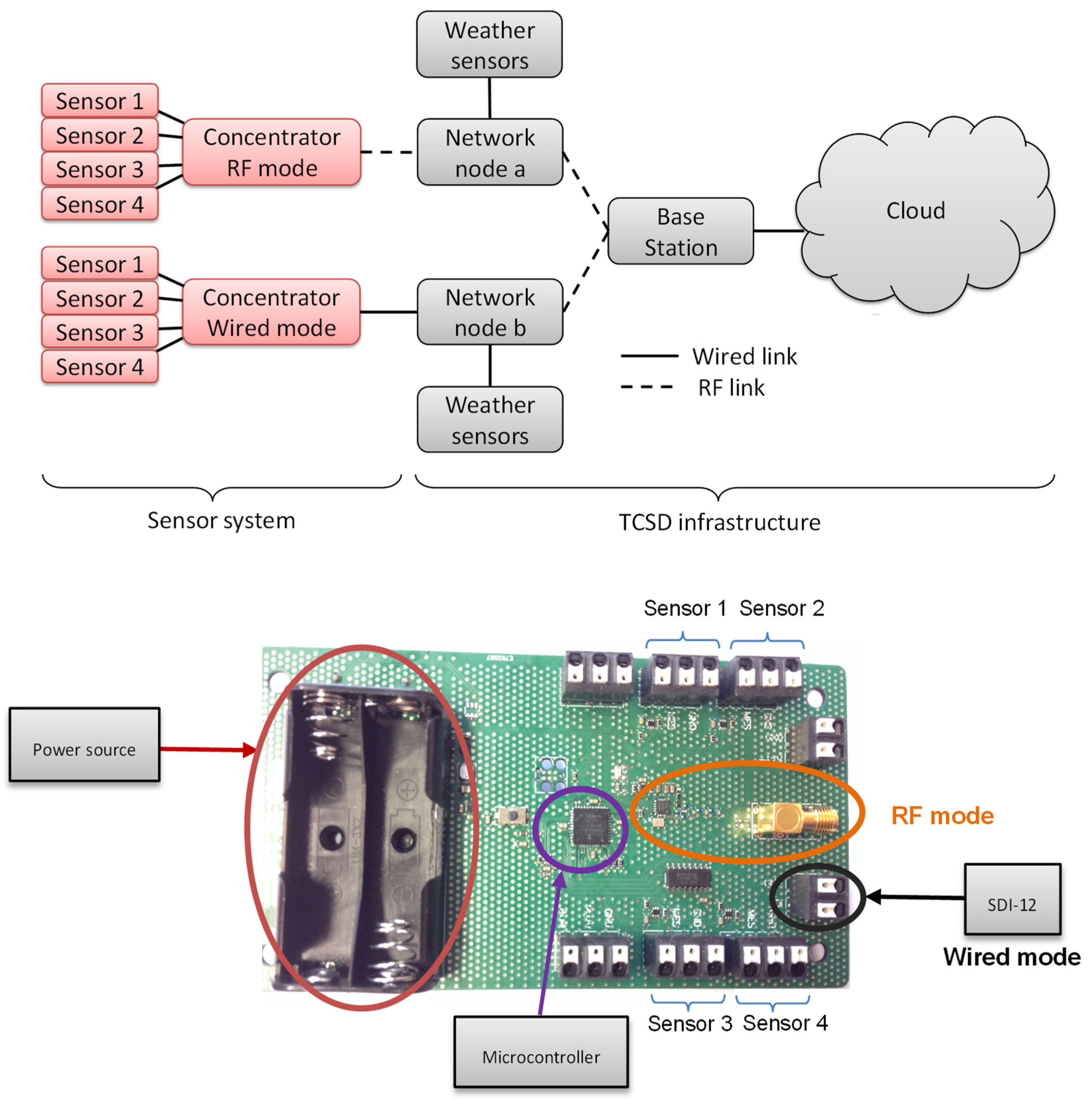
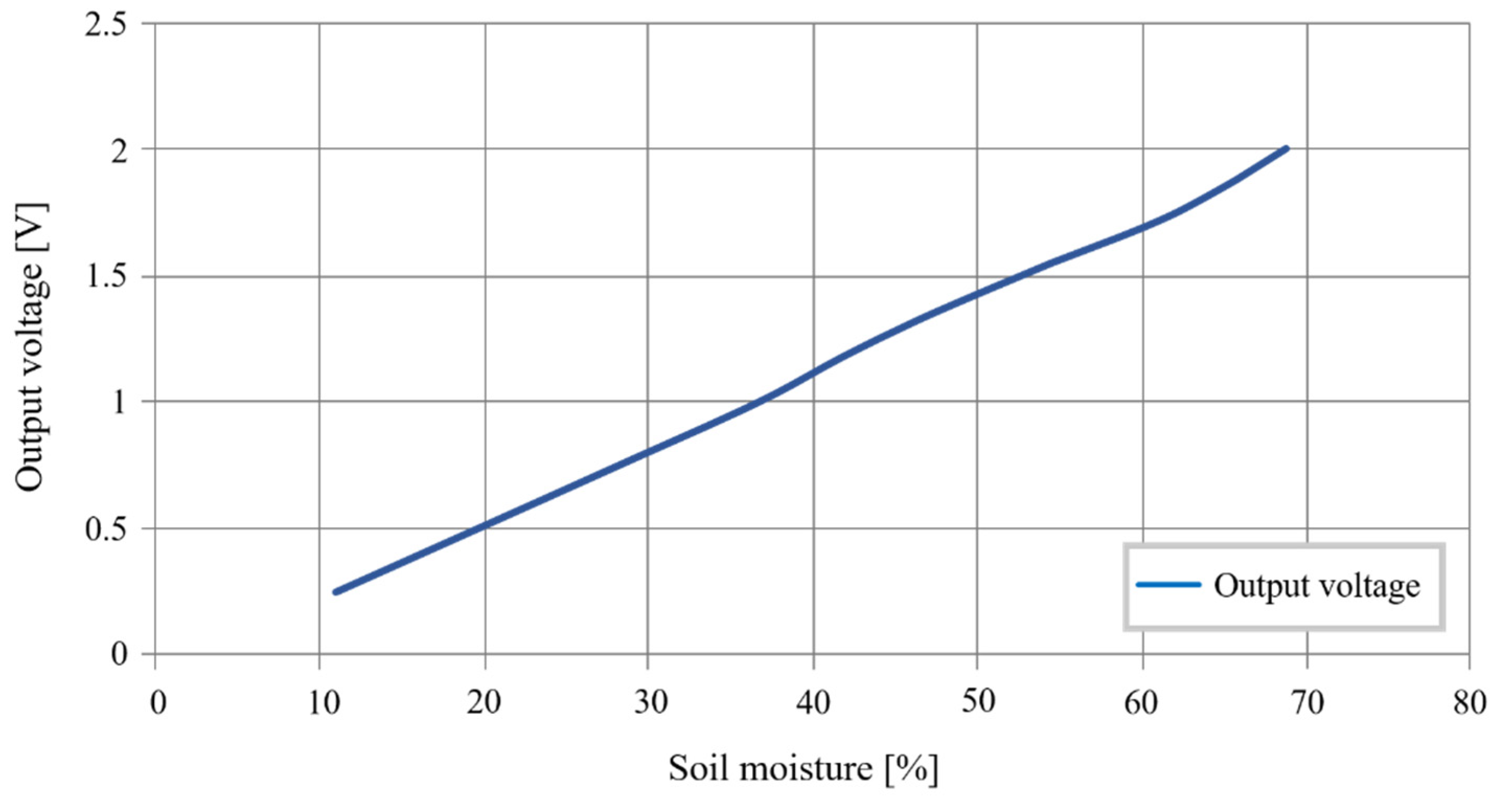

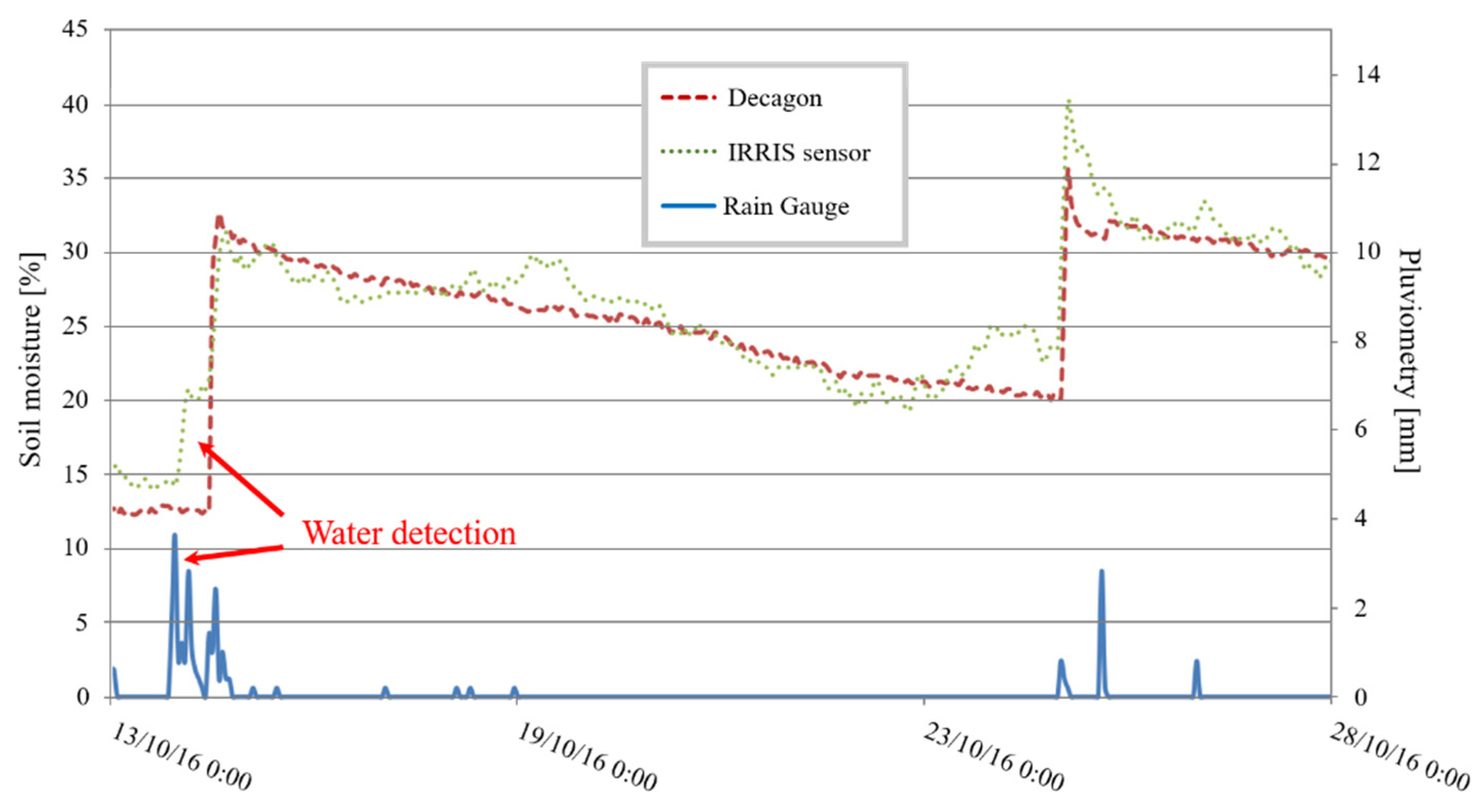
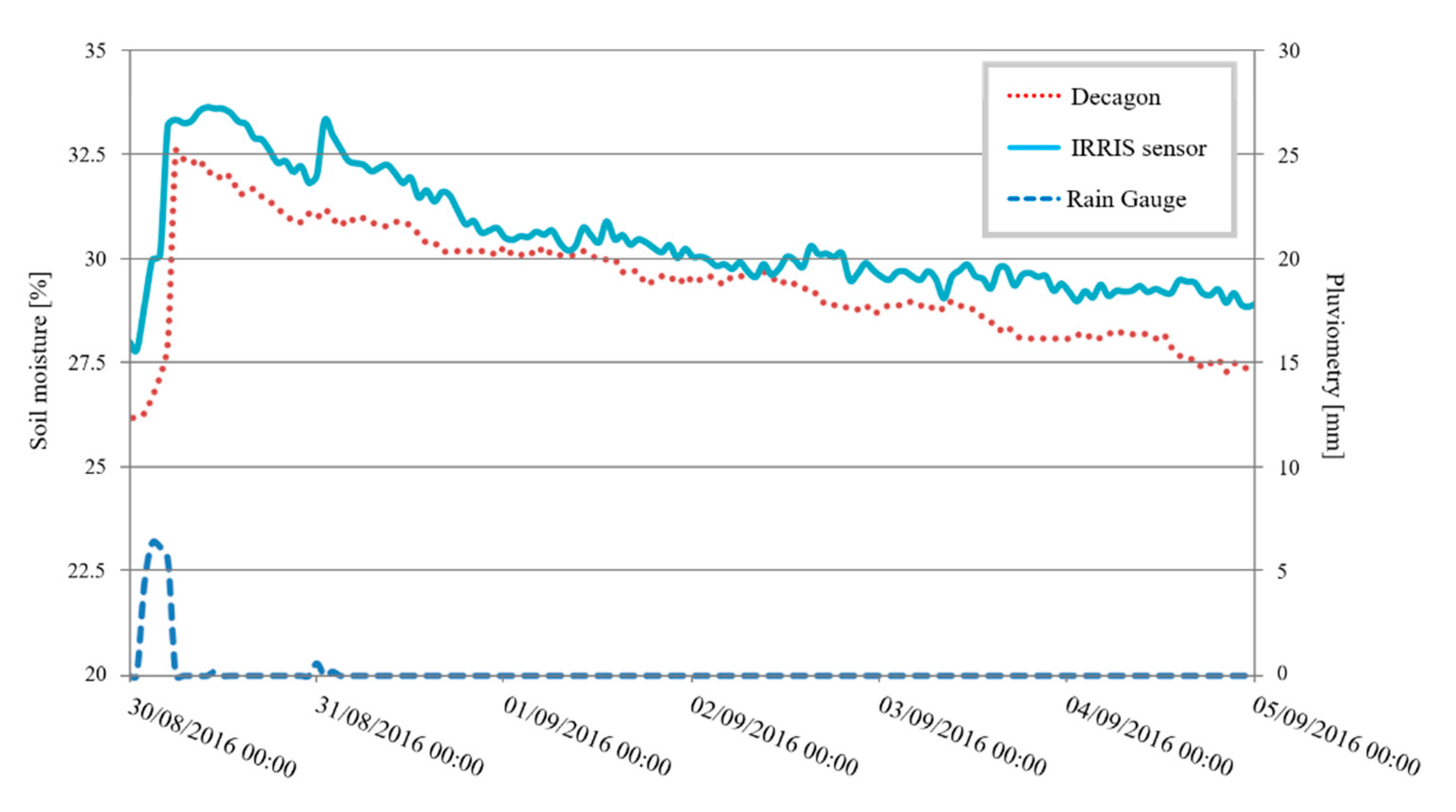
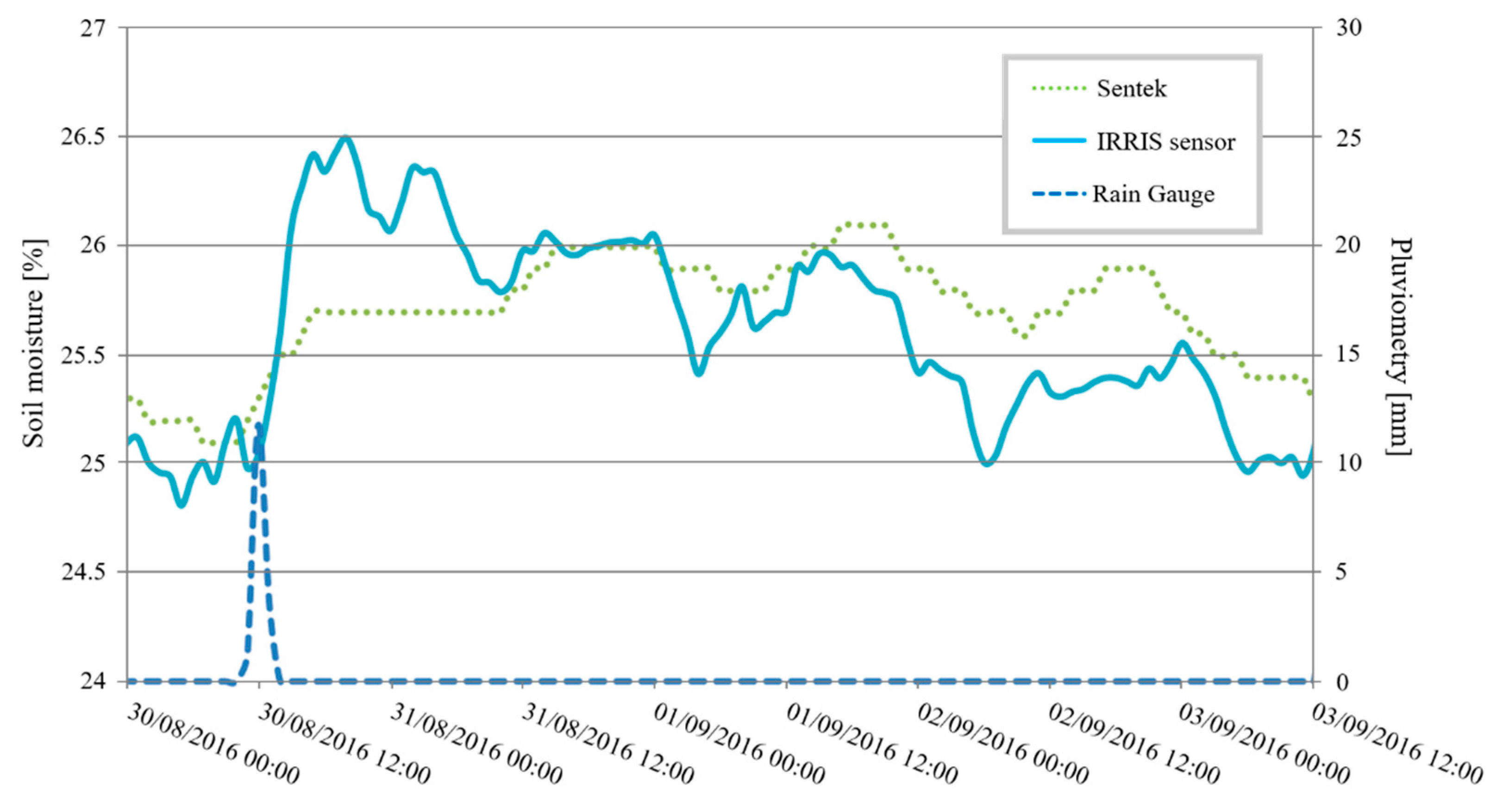
| Sensor | Diameter (mm) | Space between Electrodes (mm) | Electrodes Width (mm) | Electrodes Surface (mm2) |
|---|---|---|---|---|
| Original | 20 | 10 | 30 | 3769.91 |
| Little space | 20 | 5 | 30 | 3769.91 |
| Big electrode | 20 | 10 | 50 | 6283.19 |
| Electrode Shape | Sensitivity (pF/%) | Linear Response | Probed Soil (dm3) | Copper Surface (mm2) |
|---|---|---|---|---|
| Cylindric | 0.265 | Yes | 1.32 | 2670.35 |
| Double spiral | 0.4417 | Yes | 0.277 | 2670.35 |
| Branches | 0.7188 | No | 1.737 | 2670.35 |
Publisher’s Note: MDPI stays neutral with regard to jurisdictional claims in published maps and institutional affiliations. |
© 2020 by the authors. Licensee MDPI, Basel, Switzerland. This article is an open access article distributed under the terms and conditions of the Creative Commons Attribution (CC BY) license (http://creativecommons.org/licenses/by/4.0/).
Share and Cite
Escriba, C.; Aviña Bravo, E.G.; Roux, J.; Fourniols, J.-Y.; Contardo, M.; Acco, P.; Soto-Romero, G. Toward Smart Soil Sensing in v4.0 Agriculture: A New Single-Shape Sensor for Capacitive Moisture and Salinity Measurements. Sensors 2020, 20, 6867. https://doi.org/10.3390/s20236867
Escriba C, Aviña Bravo EG, Roux J, Fourniols J-Y, Contardo M, Acco P, Soto-Romero G. Toward Smart Soil Sensing in v4.0 Agriculture: A New Single-Shape Sensor for Capacitive Moisture and Salinity Measurements. Sensors. 2020; 20(23):6867. https://doi.org/10.3390/s20236867
Chicago/Turabian StyleEscriba, Christophe, Eli Gabriel Aviña Bravo, Julien Roux, Jean-Yves Fourniols, Michel Contardo, Pascal Acco, and Georges Soto-Romero. 2020. "Toward Smart Soil Sensing in v4.0 Agriculture: A New Single-Shape Sensor for Capacitive Moisture and Salinity Measurements" Sensors 20, no. 23: 6867. https://doi.org/10.3390/s20236867
APA StyleEscriba, C., Aviña Bravo, E. G., Roux, J., Fourniols, J.-Y., Contardo, M., Acco, P., & Soto-Romero, G. (2020). Toward Smart Soil Sensing in v4.0 Agriculture: A New Single-Shape Sensor for Capacitive Moisture and Salinity Measurements. Sensors, 20(23), 6867. https://doi.org/10.3390/s20236867





